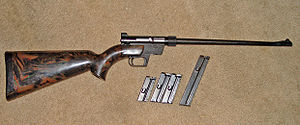
Back ArmaLite AR-7 Czech ArmaLite AR-7 Estonian ارمالایت ایآر۷ Persian AR-7 HE AR-7 ID ArmaLite AR-7 Explorer Italian AR-7 Japanese Karabin AR-7 Polish Armalite AR-7 Portuguese AR-7 Russian
| AR-7 | |
|---|---|
 ArmaLite AR-7 survival rifle with 8-, 10-, and 15-round magazines | |
| Type | Survival rifle |
| Place of origin | United States |
| Service history | |
| In service | 1959–present |
| Production history | |
| Designer | Eugene Stoner |
| Designed | 1958 |
| Variants | ArmaLite AR-7 Explorer; Charter Arms AR-7 Explorer; Charter Arms Explorer II Pistol; Israeli Pilot's Survival Rifle; Henry U.S. Survival .22 |
| Specifications | |
| Mass | 2.5 lb (1.1 kg) |
| Length | 35 in (889 mm) |
| Barrel length | 16 in (406 mm) |
| Cartridge | .22 Long Rifle |
| Action | Straight blowback-operated |
| Rate of fire | Semi-automatic |
| Muzzle velocity | 1,080 ft/s (329 m/s) to 1,280 ft/s (390 m/s) (varies by type of .22 Long Rifle cartridge) |
| Effective firing range | 109 yd (100 m) |
| Feed system | Standard 8-round magazine. 5-, 10-, 15-, 25-round magazines available. |
| Sights | Aperture rear and drift-adjustable front. |
The ArmaLite AR-7 Explorer is a semi-automatic firearm in .22 Long Rifle caliber, developed in 1959 from the AR-5 that was adopted by the U.S. Air Force as a pilot and aircrew survival weapon.[1] The AR-7 was adopted and modified by the Israeli Air Force as an aircrew survival weapon in the 1980s.
The AR-7 was designed by American firearms designer Eugene Stoner, who is most associated with the development of the ArmaLite AR-15 rifle that was adopted by the US military as the M16. The civilian AR-7's intended markets today are backpackers and other recreational users as a takedown utility rifle. The AR-7 is intended for users of recreational vehicles (automobile, airplane or boat) who might have need for a weapon for foraging or defense in a wilderness emergency.
- ^ The AR-7 exotic weapons system, Paperback: 63 pages Paladin Press (1982), ISBN 0873642422